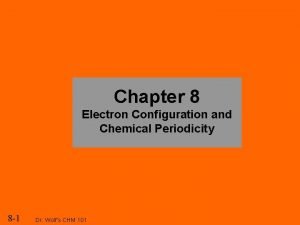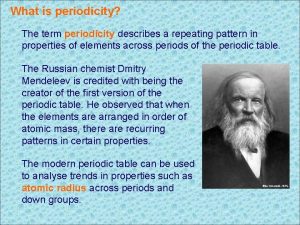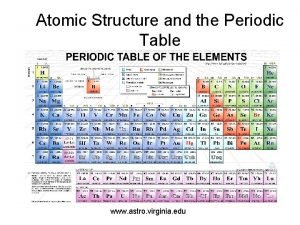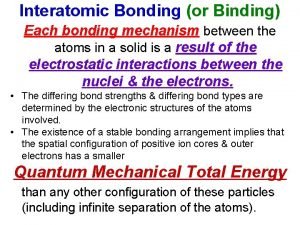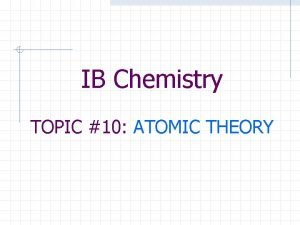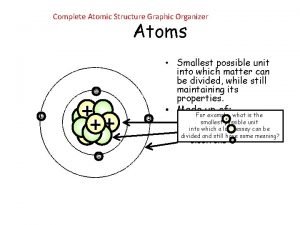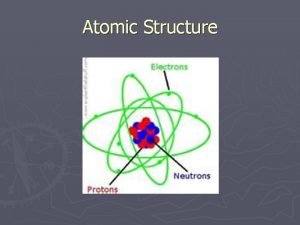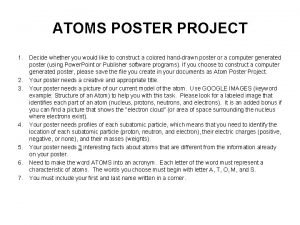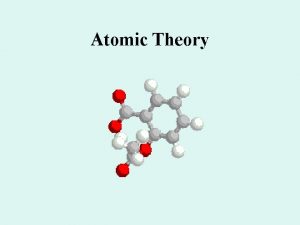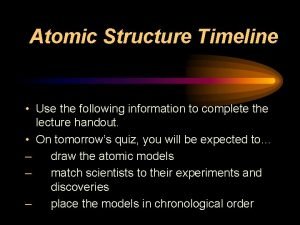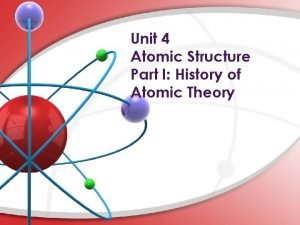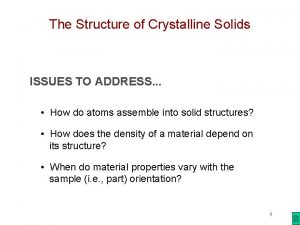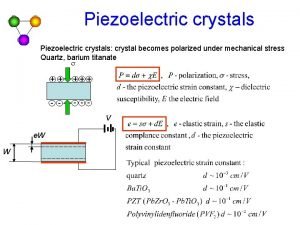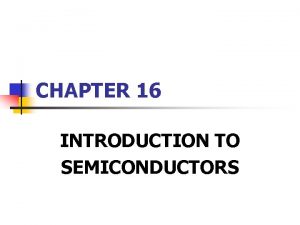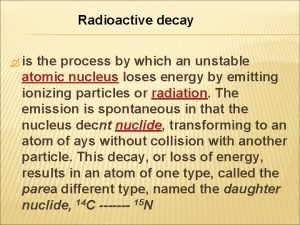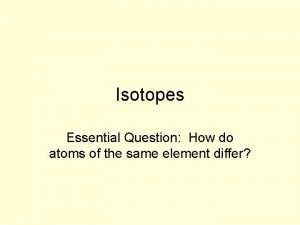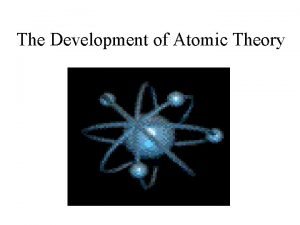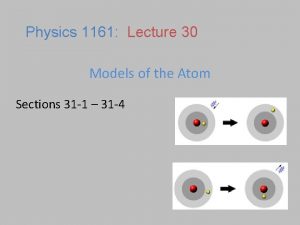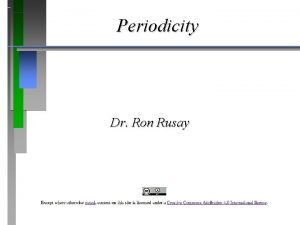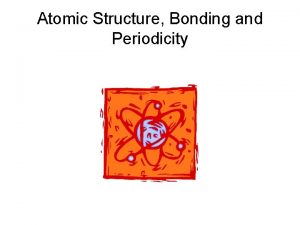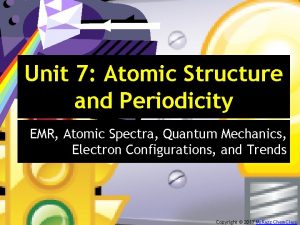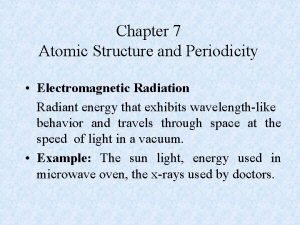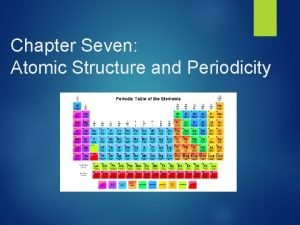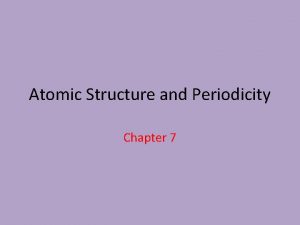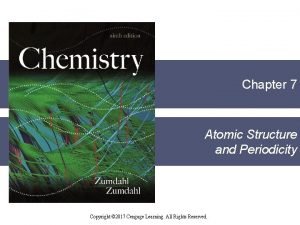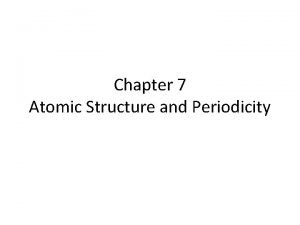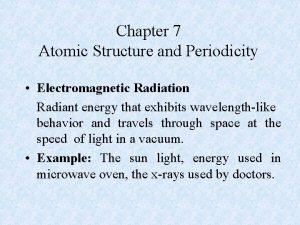Chapter 7 Atomic Structure and Periodicity Chapter 7


















































- Slides: 50

Chapter 7 Atomic Structure and Periodicity

Chapter 7 Table of Contents 7. 1 7. 2 7. 3 7. 4 7. 5 7. 6 7. 7 7. 8 7. 9 7. 10 7. 11 7. 12 7. 13 Electromagnetic Radiation The Nature of Matter The Atomic Spectrum of Hydrogen The Bohr Model The Quantum Mechanical Model of the Atom Quantum Numbers Orbital Shapes and Energies Electron Spin and the Pauli Principle Polyelectronic Atoms The History of the Periodic Table The Aufbau Principle and the Periodic Table Periodic Trends in Atomic Properties The Properties of a Group: The Alkali Metals Copyright © Cengage Learning. All rights reserved 2

Section 7. 1 Electromagnetic Radiation Different Colored Fireworks Return to TOC Copyright © Cengage Learning. All rights reserved 3

Section 7. 1 Electromagnetic Radiation Characteristics • Wavelength ( ) – distance between two peaks or troughs in a wave. • Frequency ( ) – number of waves (cycles) per second that pass a given point in space • Speed (c) – speed of light (2. 9979× 108 m/s) Return to TOC Copyright © Cengage Learning. All rights reserved 4

Section 7. 1 Electromagnetic Radiation The Nature of Waves Return to TOC Copyright © Cengage Learning. All rights reserved 5

Section 7. 1 Electromagnetic Radiation Classification of Electromagnetic Radiation Return to TOC Copyright © Cengage Learning. All rights reserved 6

Section 7. 2 The Nature of Matter • Energy is quantized. • Electromagnetic radiation is a stream of “particles” called photons. E = nh Return to TOC Copyright © Cengage Learning. All rights reserved 7

Section 7. 2 The Nature of Matter The Photoelectric Effect Return to TOC Copyright © Cengage Learning. All rights reserved 8

Section 7. 2 The Nature of Matter • Energy has mass E = mc 2 • Dual nature of light: § Electromagnetic radiation (and all matter) exhibits wave properties and particulate properties. Return to TOC Copyright © Cengage Learning. All rights reserved 9

Section 7. 3 The Atomic Spectrum of Hydrogen • Continuous spectrum (when white light is passed through a prism) – contains all the wavelengths of visible light • Line spectrum – each line corresponds to a discrete wavelength: § Hydrogen emission spectrum Return to TOC Copyright © Cengage Learning. All rights reserved 10

Section 7. 3 The Atomic Spectrum of Hydrogen Refraction of White Light Return to TOC Copyright © Cengage Learning. All rights reserved 11

Section 7. 3 The Atomic Spectrum of Hydrogen The Line Spectrum of Hydrogen Return to TOC Copyright © Cengage Learning. All rights reserved 12

Section 7. 3 The Atomic Spectrum of Hydrogen Significance • Only certain energies are allowed for the electron in the hydrogen atom. • Energy of the electron in the hydrogen atom is quantized. Return to TOC Copyright © Cengage Learning. All rights reserved 13

Section 7. 4 The Bohr Model • Electron in a hydrogen atom moves around the nucleus only in certain allowed circular orbits. • Bohr’s model gave hydrogen atom energy levels consistent with the hydrogen emission spectrum. • Ground state – lowest possible energy state (n = 1) Return to TOC Copyright © Cengage Learning. All rights reserved 14

Section 7. 4 The Bohr Model Electronic Transitions in the Bohr Model for the Hydrogen Atom a) An Energy-Level Diagram for Electronic Transitions Return to TOC Copyright © Cengage Learning. All rights reserved 15

Section 7. 4 The Bohr Model Electronic Transitions in the Bohr Model for the Hydrogen Atom b) An Orbit-Transition Diagram, Which Accounts for the Experimental Spectrum Return to TOC Copyright © Cengage Learning. All rights reserved 16

Section 7. 4 The Bohr Model • Bohr’s model is incorrect. This model only works for hydrogen. • Electrons do not move around the nucleus in circular orbits. Return to TOC Copyright © Cengage Learning. All rights reserved 17

Section 7. 5 The Quantum Mechanical Model of the Atom • We do not know the detailed pathway of an electron. • Heisenberg uncertainty principle: § There is a fundamental limitation to just how precisely we can know both the position and momentum of a particle at a given time. Δx = uncertainty in a particle’s position Δ(mν) = uncertainty in a particle’s momentum h = Planck’s constant Return to TOC Copyright © Cengage Learning. All rights reserved 18

Section 7. 5 The Quantum Mechanical Model of the Atom Physical Meaning of a Wave Function • The square of the function indicates the probability of finding an electron near a particular point in space. § Probability distribution – intensity of color is used to indicate the probability value near a given point in space. Return to TOC Copyright © Cengage Learning. All rights reserved 19

Section 7. 5 The Quantum Mechanical Model of the Atom Relative Orbital Size • Difficult to define precisely. • Orbital is a wave function. • Picture an orbital as a three-dimensional electron density map. • Hydrogen 1 s orbital: § Radius of the sphere that encloses 90% of the total electron probability. Return to TOC Copyright © Cengage Learning. All rights reserved 20

Section 7. 6 Quantum Numbers • Principal quantum number (n) – size and energy of the orbital. • Angular momentum quantum number (l) – shape of atomic orbitals (sometimes called a subshell). • Magnetic quantum number (ml) – orientation of the orbital in space relative to the other orbitals in the atom. Return to TOC Copyright © Cengage Learning. All rights reserved 21

Section 7. 6 Quantum Numbers for the First Four Levels of Orbitals in the Hydrogen Atom Return to TOC Copyright © Cengage Learning. All rights reserved 22

Section 7. 7 Orbital Shapes and Energies 1 s Orbital Return to TOC Copyright © Cengage Learning. All rights reserved 23

Section 7. 7 Orbital Shapes and Energies Two Representations of the Hydrogen 1 s, 2 s, and 3 s Orbitals Return to TOC Copyright © Cengage Learning. All rights reserved 24

Section 7. 7 Orbital Shapes and Energies 2 px Orbital Return to TOC Copyright © Cengage Learning. All rights reserved 25

Section 7. 7 Orbital Shapes and Energies 2 py Orbital Return to TOC Copyright © Cengage Learning. All rights reserved 26

Section 7. 7 Orbital Shapes and Energies 2 pz Orbital Return to TOC Copyright © Cengage Learning. All rights reserved 27

Section 7. 7 Orbital Shapes and Energies The Boundary Surface Representations of All Three 2 p Orbitals Return to TOC Copyright © Cengage Learning. All rights reserved 28

Section 7. 7 Orbital Shapes and Energies 3 dx -y Orbital 2 2 Return to TOC Copyright © Cengage Learning. All rights reserved 29

Section 7. 7 Orbital Shapes and Energies 3 dxy Orbital Return to TOC Copyright © Cengage Learning. All rights reserved 30

Section 7. 7 Orbital Shapes and Energies 3 dxz Orbital Return to TOC Copyright © Cengage Learning. All rights reserved 31

Section 7. 7 Orbital Shapes and Energies 3 dyz Orbital Return to TOC Copyright © Cengage Learning. All rights reserved 32

Section 7. 7 Orbital Shapes and Energies Orbital Return to TOC Copyright © Cengage Learning. All rights reserved 33

Section 7. 7 Orbital Shapes and Energies The Boundary Surfaces of All of the 3 d Orbitals Return to TOC Copyright © Cengage Learning. All rights reserved 34

Section 7. 7 Orbital Shapes and Energies Representation of the 4 f Orbitals in Terms of Their Boundary Surfaces Return to TOC Copyright © Cengage Learning. All rights reserved 35

Section 7. 8 Electron Spin and the Pauli Principle Electron Spin • Electron spin quantum number (ms) – can be +½ or -½. • Pauli exclusion principle - in a given atom no two electrons can have the same set of four quantum numbers. • An orbital can hold only two electrons, and they must have opposite spins. Return to TOC Copyright © Cengage Learning. All rights reserved 36

Section 7. 11 The Aufbau Principle and the Periodic Table Hund’s Rule • The lowest energy configuration for an atom is the one having the maximum number of unpaired electrons allowed by the Pauli principle in a particular set of degenerate (same energy) orbitals. Return to TOC Copyright © Cengage Learning. All rights reserved 37

Section 7. 11 The Aufbau Principle and the Periodic Table Orbital Diagram • A notation that shows how many electrons an atom has in each of its occupied electron orbitals. Oxygen: 1 s 22 p 4 Oxygen: 1 s 2 p Return to TOC Copyright © Cengage Learning. All rights reserved 38

Section 7. 11 The Aufbau Principle and the Periodic Table Valence Electrons • The electrons in the outermost principal quantum level of an atom. 1 s 22 p 6 (valence electrons = 8) • The elements in the same group on the periodic table have the same valence electron configuration. Return to TOC Copyright © Cengage Learning. All rights reserved 39

Section 7. 11 The Aufbau Principle and the Periodic Table The Orbitals Being Filled for Elements in Various Parts of the Periodic Table Return to TOC Copyright © Cengage Learning. All rights reserved 40

Section 7. 12 Periodic Trends in Atomic Properties Hund’s Rule • The lowest energy configuration for an atom is the one having the maximum number of unpaired electrons allowed by the Pauli principle in a particular set of degenerate (same energy) orbitals. Return to TOC Copyright © Cengage Learning. All rights reserved 41

Section 7. 12 Periodic Trends in Atomic Properties Orbital Diagram • A notation that shows how many electrons an atom has in each of its occupied electron orbitals. Oxygen: 1 s 22 p 4 Oxygen: 1 s 2 p Return to TOC Copyright © Cengage Learning. All rights reserved 42

Section 7. 12 Periodic Trends in Atomic Properties Valence Electrons • The electrons in the outermost principal quantum level of an atom. 1 s 22 p 6 (valence electrons = 8) • The elements in the same group on the periodic table have the same valence electron configuration. Return to TOC Copyright © Cengage Learning. All rights reserved 43

Section 7. 12 Periodic Trends in Atomic Properties The Orbitals Being Filled for Elements in Various Parts of the Periodic Table Return to TOC Copyright © Cengage Learning. All rights reserved 44

Section 7. 12 Periodic Trends in Atomic Properties Return to TOC Copyright © Cengage Learning. All rights reserved 45

Section 7. 12 Periodic Trends in Atomic Properties • The arrangement of the periodic table means that the physical properties of the elements follow a regular pattern. • We can look at the size of atoms, or their atomic radius. • There are two trends for atomic radii: – Atomic radius decreases as you go up a group. – Atomic radius decreases as you go left to right across a period. Return to TOC Copyright © Cengage Learning. All rights reserved 46

Section 7. 12 Periodic Trends in Atomic Properties 여러 전자가 있는 원자에서 한 전자에 미치는 유효 핵전하 (Z Z Z eff eff , effective nuclear charge)는 가려막기상수(shielding constant) s 만큼 감소. =Z-s 0<s<Z Z – 최외각 전자를 제외한 내부전자의 수 Z 내부전자수 Z eff 원자반지름 Na 11 10 1 186 Mg 12 10 2 160 Al 13 10 3 143 Si 14 10 4 132 같은 주기에서 Zeff 가 증가하면, 반지름이 줄어든다 Return to TOC Copyright © Cengage Learning. All rights reserved 47

Section 7. 12 Periodic Trends in Atomic Properties The Orbitals Being Filled for Elements in Various Parts of the Periodic Table Return to TOC Copyright © Cengage Learning. All rights reserved 48

Section 7. 13 The Properties of a Group: The Alkali Metals Special Names for Groups in the Periodic Table Return to TOC Copyright © Cengage Learning. All rights reserved 49

Section 7. 13 The Properties of a Group: The Alkali Metals Versus Nonmetals Return to TOC Copyright © Cengage Learning. All rights reserved 50
 Oxygen periodic trends
Oxygen periodic trends Chapter 7 atomic structure and periodicity
Chapter 7 atomic structure and periodicity Ap chemistry atomic structure and periodicity
Ap chemistry atomic structure and periodicity 1s 22 s22 p63 s2
1s 22 s22 p63 s2 Electronic configuration of mo (z=42)
Electronic configuration of mo (z=42) What is periodicity?
What is periodicity? Thsteps quick reference guide
Thsteps quick reference guide Cara memakan ikan
Cara memakan ikan Chemsheets periodicity
Chemsheets periodicity Aap bright futures periodicity schedule
Aap bright futures periodicity schedule Atomic size and ionization energy
Atomic size and ionization energy Wuchereria
Wuchereria Relative formula mass of hcl
Relative formula mass of hcl Abundance calculation chemistry
Abundance calculation chemistry Difference between atomic mass and atomic number
Difference between atomic mass and atomic number Radius trend periodic table
Radius trend periodic table Atomic radius periodic table
Atomic radius periodic table Atomic number vs atomic radius
Atomic number vs atomic radius Chapter 4 atomic structure vocabulary
Chapter 4 atomic structure vocabulary Atomic structure
Atomic structure Atomic structure and properties ap chemistry
Atomic structure and properties ap chemistry Structure of atom periodic table
Structure of atom periodic table Atomic structure apeman practice and homework
Atomic structure apeman practice and homework What is interatomic bonding
What is interatomic bonding Arrangement of subatomic particles
Arrangement of subatomic particles 460 democritus atom model
460 democritus atom model Conductors atomic structure
Conductors atomic structure What is successive ionisation energy
What is successive ionisation energy Ib chemistry atomic structure
Ib chemistry atomic structure Complete atom
Complete atom Atomic theory timeline
Atomic theory timeline Z atomic symbol
Z atomic symbol Tungsten atomic structure
Tungsten atomic structure Nuclear symbol notation
Nuclear symbol notation Atom poster project
Atom poster project Atoms graphic organizer
Atoms graphic organizer Schrodinger atom model
Schrodinger atom model Schrodinger
Schrodinger Atomic history webquest
Atomic history webquest Bcc apf
Bcc apf Piezoelectric crystal atomic structure
Piezoelectric crystal atomic structure Just one grain of sand
Just one grain of sand Biasn
Biasn Atomic structure
Atomic structure Bohr rutherford diagram magnesium
Bohr rutherford diagram magnesium What is this
What is this What does the atomic number represent
What does the atomic number represent Discovery of atomic structure
Discovery of atomic structure What does the greek word atomos mean
What does the greek word atomos mean Bohr radius of hydrogen atom
Bohr radius of hydrogen atom What is atomicity
What is atomicity




